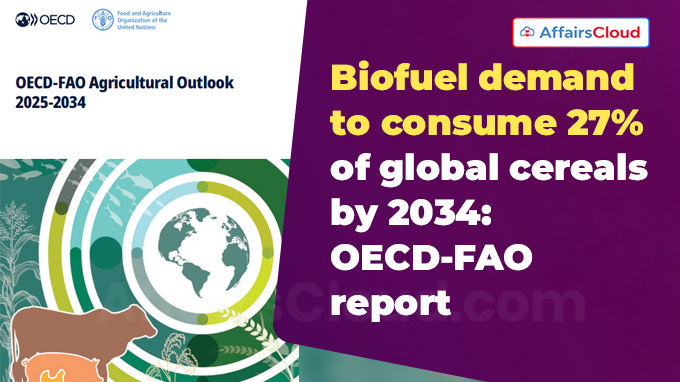 In July 2025, the Organisation for Economic Co-operation and Development (OECD) and the Food and Agriculture Organization of the United Nations(FAO) jointly released the 21st edition of the OECD-FAO Agricultural Outlook 2025–2034 report.
In July 2025, the Organisation for Economic Co-operation and Development (OECD) and the Food and Agriculture Organization of the United Nations(FAO) jointly released the 21st edition of the OECD-FAO Agricultural Outlook 2025–2034 report.
- As per the report, by 2034, only 40% of global cereal production will be consumed directly by humans, while 33% will be used for animal feed and 27% for biofuel and industrial uses.
Key Findings:
The report presents a 10-year forward-looking assessment of global agricultural trends, highlighting a significant shift in cereal usage, intensifying competition among food, feed, and fuel, rising environmental pressures, and growing nutritional disparities across income groups.
1.Global Biofuel Demand Drivers:
i.The report forecasts that global biofuel demand will grow at an average rate of 0.9% annually through 2034, up from the earlier estimate of 0.6%.
ii.India, along with Brazil and Indonesia, will be the key drivers of this accelerated growth, due to policy support, energy security goals, and rising energy demand in emerging economies.
2.Agricultural Production Growth:
i.Global cereal production is projected to grow at 1.1% per year, driven primarily by yield improvements (0.9% annually).
ii.Harvested area expansion will slow to 0.14% per year, significantly down from 0.33% seen over the past decade, indicating land constraints and sustainability efforts.
iii.India and Southeast Asian nations will contribute 39% to the global cereal consumption growth by 2034, up from 32% over the past decade.
- China will witness a sharp decline in its share of global cereal consumption, falling to 13% from 32%.
3.Rising Animal-Source Foods
i.Total agricultural and fish production is forecast to grow by 14% by 2034, supported by productivity gains in middle-income countries.
ii.The production of meat, dairy, and eggs is projected to rise by 17%, leading to a 7% increase in global livestock inventories.
iii.This growth will result in a 6% rise in direct agricultural greenhouse gas (GHG) emissions by 2034, though carbon intensity per unit of output will decline.
4.Nutritional Inequalities:
i.Global average per capita daily calorie intake from animal and fish products will increase by 6% over the next decade.
ii.In lower-middle-income countries, this increase will be significantly higher at 24%, with average intake reaching 364 kilocalories (kcal) per day by 2034, surpassing the FAO’s benchmark of 300 kcal per day for a healthy diet.
iii.In contrast, in low-income countries, average intake will remain critically low at just 143 kcal/day, reflecting persistent nutritional disparities.
5.Trade & Global Caloric Flows:
i.The report projects that 22% of all calories produced globally will cross international borders by 2034.
ii.This trend highlights growing global reliance on shared food systems and the need for fair, transparent trade to balance supply, control prices, and improve food access.
6.Solution to GHG emission:
To eliminate global undernourishment and achieve a 7% reduction in direct agricultural GHG emissions by 2034, the report calls for:
- A 15% increase in agricultural productivity, particularly in low- and middle-income nations
- Scaling emission-reduction technologies, including precision farming, improved livestock feed and herd management, and efficient water and manure use.
About Organisation for Economic Cooperation and Development (OECD):
Secretary General (SG) – Mathias Hubert Paul Cormann
Headquarters – Paris, France
Established – 1961
About Food and Agriculture Organisation (FAO):
Director-General (DG)- Qu Dongyu
Headquarters – Rome, Italy
Established – 1945




